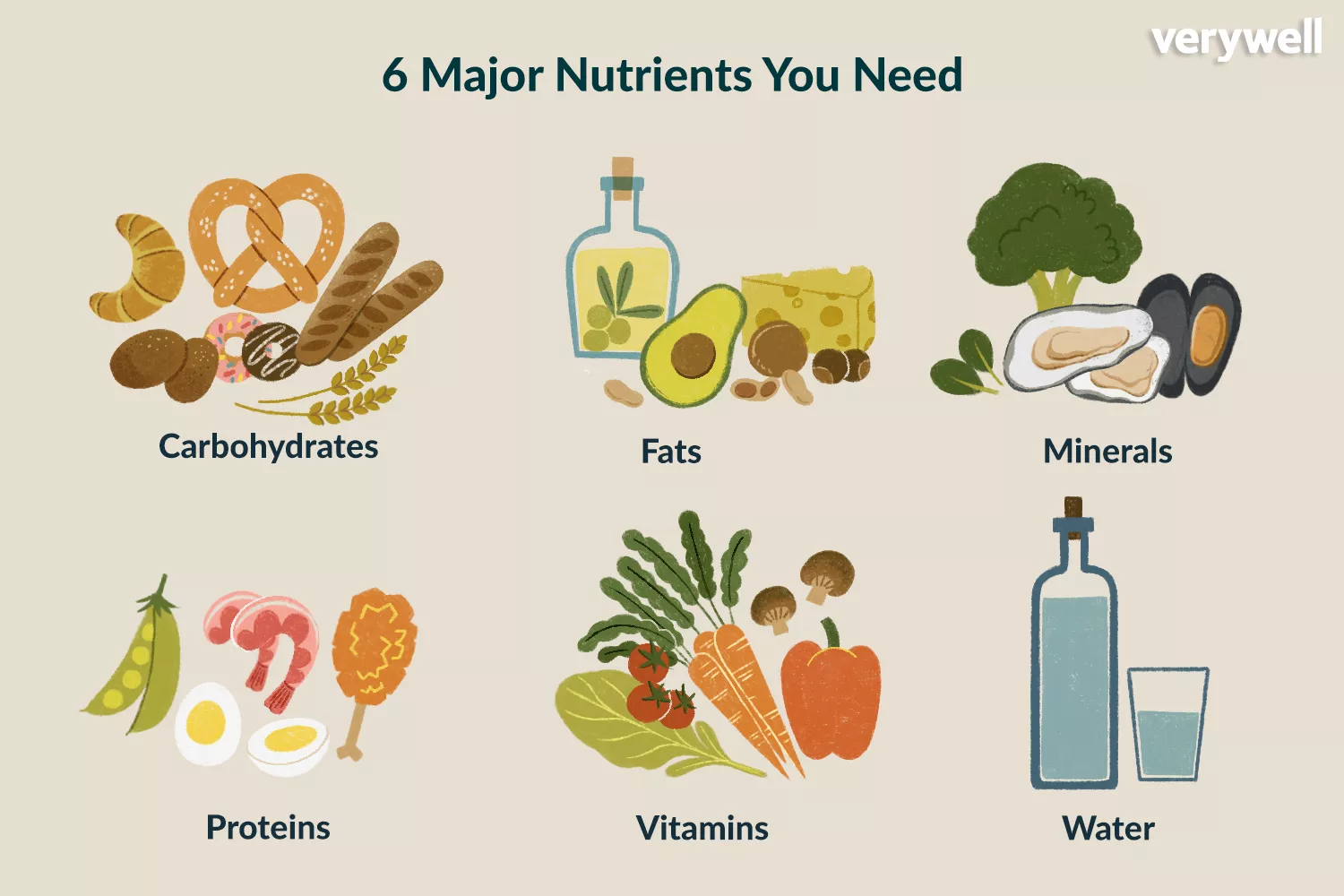The definition of "nutrient" is a substance that provides nourishment for growth and the maintenance of life, which is a broad definition. Nutrients in the field of nutrition and diet are more specific. In fact, there are six categories of nutrients, all of which are necessary to sustain life.
Nutrients: 6 Major Categories
Macronutrients vs. Micronutrients
Humans like to put things into categories because it's easy to remember what they do and we can compare and contrast them with other things. In nutrition, we often group nutrients by size or what they do in the body. We start with two groups, micronutrients and macronutrients (water is usually left alone in its own group).
Carbohydrates, proteins, and fats are called macronutrients because they're large, and energy nutrients because they provide the fuel your body needs to do things. Vitamins and minerals are called micronutrients because they're much smaller in comparison. That doesn't mean they're less important; they're still essential nutrients, but you only need little bits.
Micronutrients can be classified by whether they're soluble in fat or water. Vitamins A, D, E, and K are fat-soluble, and the B-complex vitamins and vitamin C are water-soluble. Minerals are grouped as major minerals or trace minerals, depending upon how much of each mineral is necessary.
You can also group nutrients by whether or not they are organic, by which we mean organic chemistry, not organic farming or food production. Water and minerals are inorganic while the rest are organic because they contain carbon atoms.
Why Nutrients Matter
Nutrients are important for proper health and development. The following are key reasons nutrients in your food matter.
Energy Production
Carbohydrates, fats, and proteins provide the energy your body needs to carry out all the biochemical reactions that occur each day and night, and are included in supplements to support your workouts. The energy is measured in calories (kilocalories, technically, but we usually call them calories). Gram for gram, fat has more calories than either carbohydrates or protein; one gram of fat has nine calories, and the other two have four calories per gram.
They're Needed for Body Structures
Fats, proteins, and minerals are raw materials that build and maintain tissues, organs, and other structures such as bones and teeth. Carbohydrates aren't on this list, but your body can take any extra carbohydrates and convert them into fat to be stored in adipose tissue. We can also store carbohydrates as glycogen in our muscles and liver and use them as energy. When these tanks are full we store carbohydrates as fat.
They Regulate Body Functions
Nutrients help regulate body functions. All six classes regulate various body functions such as sweating, temperature, metabolism, blood pressure, thyroid function, and many others. When all different functions are balanced, your body is in homeostasis.
What Are Phytonutrients?
You might have read about phytonutrients, which aren't included in the major classes. Phytonutrients are chemical compounds found in plants that offer potential health benefits. There are many names for phytonutrients such as flavonoids, phytochemicals, flavones, isoflavones, catechins, and anthocyanidins. Phytonutrients are commonly referred to include beta-carotene, lycopene, and resveratrol.
Emerging studies are investigating the role that phytonutrients play in human health. Some researchers believe that they can provide substantial benefits. However, since they typically occur in foods that are also nutritious, it can be difficult to know how much of the health benefit is due to the regular nutrients or the phytonutrients.
Some better-known phytonutrients include polyphenols and carotenoids.
Fiber is a type of carbohydrate your body can't digest so it doesn't provide energy or structure. Fiber is necessary for digestive system function because it adds bulk to stool. There are two types of fiber: soluble fiber that dissolves in water and insoluble fiber that doesn't.
A Word From Verywell
Understanding the role of different types of nutrients on your overall health and daily function may seem overwhelming. While learning about how nutrients help our bodies stay viable might help you to make food decisions, you don't have to overthink each vitamin, mineral, or macronutrient. When choosing foods and planning meals, think about consuming a wide variety of products that you enjoy—fruits and veggies in a variety of colors, a range of grains, proteins, and healthy fats, and a few treats and indulgences that put a smile on your face. A balanced diet looks different for everyone.

:max_bytes(150000):strip_icc():format(webp)/shereen-1f60ac63296d45eb89b4c7a7d782067e-5608c06027ba4ebeb5c54ccdc47f9d42-124899b94c76488b9fb1896447b45474.jpg)
:max_bytes(150000):strip_icc():format(webp)/the-best-b12-supplements-for-vegans-and-vegetarians-according-to-a-dietitian-tout-6e8863b1e9c64ee4bfb0d4cb3edb1baf.jpg)
:max_bytes(150000):strip_icc():format(webp)/vwt-tanita-hd-384-digital-bathroom-scale-gabby-applebury-6-22169b34dd9846cdaf1f2fbef2f6d4fc.jpeg)
:max_bytes(150000):strip_icc():format(webp)/almonds-crop-fd1e7bb5b89b436f814cdb290420abdc.jpg)
:max_bytes(150000):strip_icc():format(webp)/best-vitamin-brands-4843442-Fit-7fbb1bb223954f2e81f8486eb1403fb4.jpg)
:max_bytes(150000):strip_icc():format(webp)/vwt-product-brodo-hearth-bone-broth-jthompson-0226-5fee0fa35a2444b1bb2a1e701dbdf20e.jpeg)
:max_bytes(150000):strip_icc():format(webp)/vwt-product-ascent-native-fuel-micellar-casein-powder-jjuliao-8336-c5a776a8ea5e4359ae4d25cc54da4241.jpeg)
:max_bytes(150000):strip_icc():format(webp)/GettyImages-1323046186-a10a0b2fbf4d425092f0abc4cd76c501.jpeg)
:max_bytes(150000):strip_icc():format(webp)/72135542-crop-56a6b63d3df78cf7728fd584.jpg)
:max_bytes(150000):strip_icc():format(webp)/macronutrients-crop-46020d95fa694c73a24f89b5e86f7668.jpg)
:max_bytes(150000):strip_icc():format(webp)/fruit-1af8f9b61ca94246a3a404e03810f163.jpg)
:max_bytes(150000):strip_icc():format(webp)/woman-sleeping-on-sofa-107240095-88a29f129d234b69a09f904f1541d233.jpg)
:max_bytes(150000):strip_icc():format(webp)/whole-grain-cereal-crop-dc2395d8487b401fb560c5503b640741.jpg)
:max_bytes(150000):strip_icc():format(webp)/invert-sugar-crop-27de9e9d0cad4b82a5b3bc8d4851f18c.jpg)
:max_bytes(150000):strip_icc():format(webp)/best-fiber-supplements-for-digestion-health-tout-cc5f01732f1e466e83fd0869b29596db.jpg)
:max_bytes(150000):strip_icc():format(webp)/best-green-teas-5115813_Fit-80af7f827cec4637b5cc18fa1bd1800a.jpg)
:max_bytes(150000):strip_icc():format(webp)/protein-assortment_crop-b134dc933ea14d18a2e9ba957d63b685.jpg)